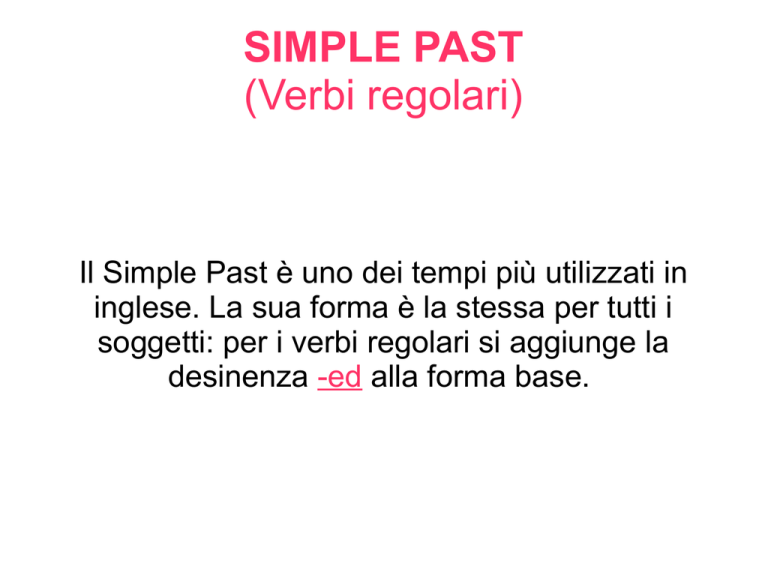
SIMPLE PAST
(Verbi regolari)
Il Simple Past è uno dei tempi più utilizzati in
inglese. La sua forma è la stessa per tutti i
soggetti: per i verbi regolari si aggiunge la
desinenza -ed alla forma base.
Il Simple Past può essere tradotto in italiano con
l'imperfetto, il passato prossimo e il passato
remoto dell'indicativo, o con l'imperfetto del
congiuntivo.
Verbi che terminano in...
Come costruire il simple
past...
Esempio
-e
Aggiungere -d
Live-lived
Date-dated
Consonante +y
Cambiare y in i, poi
aggiungere -ed
Try- tried
Cry-cried
1 vocale + 1 consonante
(tranne w e y)
Raddoppiare la consonante,
poi aggiungere -ed
Unzip-unzipped
Stop-stopped
Tutti gli altri
Aggiungere -ed
Fill-filled
Boil-boiled
FORMA INTERROGATIVA e
NEGATIVA del Simple Past Tense
La forma negativa e la forma interrogativa del
Simple Past si formano con l'ausiliare did seguito
dalla forma base del verbo principale.
FRASE AFFERMATIVA
NEGATIVA FORMALE
NEGATIVA INFORMALE
I had a car
I did not have a car
I didn't have a car
You drank my beer
Idid not drink my beer
I didn't drink my beer
They were in the pak
They were not in the park
They weren't in the park
He was here yesterday
He was not here
yesterday
He wasn't here yesterday
Nella forma interrogativa l'ausiliare viene posto
davanti al soggetto. Con il verbo “essere”, anche
in questo caso, “did” non si utilizza.
FRASE AFFERMATIVA
FRASE INTERROGATIVA
He brought his friend
Did he bring his friend?
They had a party
Did they have a party?
You were here
Were you here?
She was sick
Was she sick?
